JELLYFISH
When I was young, we were conditioned to be terrified of jellyfish. As you'll see in the many news accounts that follow, it's still a deep, consistent meme across cultures here on Earth, and I'm catching on to the fact that they're beautiful, and very important creatures in the great scheme of things.
At the New Jersey shore in the 1970's, I remember my dad educating me about the Portuguese man-of-war, Jellyfish, and how terribly deadly and dangerous it was. I saw one, once. Now it's occurring to me that jellyfish are metaphorical Canaries in the coal mine from an Etheric perspective. When the energetic environment goes bad, the jellyfish take off.
Most remarkably, I believe they may take off not geographically, but rather interdimensionally. Leaving this dimension or plane and going to one where the energy will support their existence.
And, now that the Ether has returned to its ages-long, natural state of life and vitality, they're reappearing, "winking back into existence", from our perspective. This is all speculation, of course.
But I can tell you that the reason that the most important of the many reasons that research of Sasquatch and what we euphemistically call "Lake Monsters" is forbidden is the fact that they are interdimensional in nature.
Another insight I had while researching jellyfish is that they don't have brains or nervous systems. When I read that, while looking at a picture of one, I thought "it's like a flower, an ocean flower". I'm just calling that out there.
In any case, we shall now investigate jellyfish, which are booming and burgeoning to a level not seen in my lifetime.
In August 2008, BBC news Devon, England said “ ‘Rare’ jellyfish is spotted in cove”.
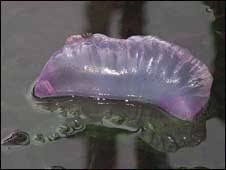
Where, under false guise of familiarity, the headline omits any indication of the location, to make the subject virtually unsearchable.
The article continues: “A ‘rare’ Portuguese man-of-war jellyfish has been discovered in a cove in Devon. Mr Lavis, who still lives in the bungalow he was born in, said he had not seen ‘any’ of the jellyfish in the cove ‘for nearly 50 years’.”
Something that hasn’t been since in 50 years isn’t “rare”, it’s “unheard of”.
The article continues: ‘An’ aquarium said it was ‘not unheard of’ for them to be found.”
The fact that is says “ ‘an’ aquarium, versus the name of an aquarium, along with the name and title of the person being quoted, shows us that ‘not unheard of for them to be found” is completely made up, out of whole cloth. They’re a Trusted Authority figure, telling the Big Lie with the firmness of purpose that goes with complete honesty.
In the headline, “ ‘rare’ jellyfish is, counterintuitively, a hedge. In that “never” seen is stronger than something only “rarely” seen.
Jellyfish are booming and burgeoning in Devon, England to a level not seen in Mr. Lavis’ lifetime.
In September 2010, the Australian said “Last week Conservation International reported that its scientists had ‘rediscovered’ three species of amphibians, including a Mexican salamander ‘not seen since 1941’ ”.
The interdimensional nature of Salamanders makes this comment of particular interest to me. I’d invite the advanced reader to peruse my “Salamander Bloodline” articles, if it piques their own, as well.
“Rediscovered” is some brave Victorian bullshit, put forward to keep your eye off the fact that they all apparently winked back into existence. It may be that species are reappearing in our environment as the Ether continues to improve in health to a level where their lives can be sustained. The mechanics of life in this dimension and others not being precisely as we’ve been told. But that’s just speculation.
Not seen since 1941…compressing the story for you: the Death energy level in the Ether got pumped up with World War II, and didn’t drop back down to healthy levels until 2010 or so, as the widespread distribution of simple, inexpensive Orgonite devices based upon Wilhelm Reich’s work brought the Ether back to it’s ages-long state of health and vitality. With the Jellyfish one of the metaphorical “canaries in the coal mine”.
In June 2011, at the start of the great positive transformation, | mélange asked “Will’ jellyfish ‘take over the oceans’ ‘?’
In July 2013, NBC Los Angeles said “ ‘Rare’ Jellyfish With 25-Foot Long Tentacles ‘Appears’ in California”.
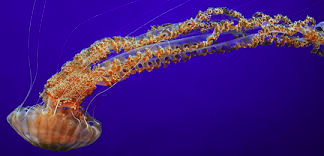
Where the general “rare” is used as a hedge providing the name of the Jellyfish. Propagandists know that sixty to seventy percent of readers only read the headlines, so this tactic “compartmentalizes” the information with an effectiveness shown by the spectacular, conditioned ignorance of the majority of the populace.
“Appears” is complex. One one level, it’s a Middle Ages, mouth-breather thing to say. Yet it may be the cold truth - that species are reappearing in our environment as the Ether continues to improve in health to a level where their lives can be sustained. Even to the point of “winking back into existence”, from our perspective. The mechanics of life in this dimension and others not being precisely as we’ve been told. But that’s just speculation.
The article continues: “Several swimmers at a Southern California beach were stung by the ‘rare’ Black Jellyfish, a marine animal who's tentacles can grow up to 30 feet long. .... A breed not seen since 1920 reemerges and ‘scientists’ link it to ‘global warming’ ‘?’
Where the general “scientists” is proof that no scientists were, in fact consulted for the article. Otherwise they’d have been quoted and named, according to strict journalistic rules. It’s just made up bluster from the generational Satanist propagandist at NBC Los Angeles. Not everyone at NBC Los Angeles is a generational Satanist, but all of them that write articles that get to the newswire.
We’ve also learned that ‘rare’ was used as a hedge a second time in the headline, in that something that shows up once every hundred years is beyond merely ‘rare’.
The fact that there’s a question mark behind the “global warming” plausible-deniability excuse is that the propaganda is well past its sell-by date, and is now back to trial-balloon status.
In October 2013, qz.com Satanically inverts a jellyfish population booming and burgeoning to unprecedented health as “Jellyfish are taking over the seas, and it might be too late to stop them”.
In November 2013, the U.K.’s Daily Mail wrote of “The Cookii ‘monster’: Huge ‘deadly’ pink jellyfish has been ‘discovered’ “
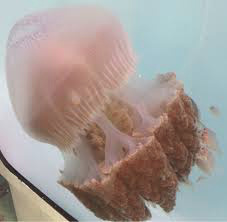
The article continues: “A jellyfish with a powerfully toxic sting has been rediscovered more than 100 years after the last recorded sighting of it. The ‘incredibly rare’ Crambione Cookii has not been seen since 1910 but has been recently ‘spotted’ off the coast of Queensland, Australia, where it was captured.”
The servants of Death did what they could by immediately capturing and killing the creature, and the Mouthpiece of the State dubbed the jellyfish had been “spotted” and then “captured”. They falsely call it a “discovery” in the headline, then walk that back to “rediscovered”. They shook the “discovery” doll to distract you from the fact that it apparently winked back into existence.
Where the lurid-but-accurate “Incredibly rare”, is still a hedge back from “previously thought extinct”.
In August 2014, the U.K.’s Independent said “ ‘Rare’ Jellyfish Spotted ‘For First Time In 70 Years’”.
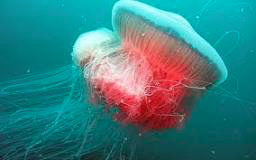
Where “rare”, while accurate, is still a hedge back from “previously thought extinct”. Something
that shows up once every seventy years is beyond merely ‘rare’. It’s used as a hedge a second time as an excuse to not mention the actual name of the Jellyfish, which makes the subject much less searchable, and also increases the chance of you not going on
to read the article. The propagandist knows that sixty to seventy percent of readers only read the headlines, so this tactic “compartmentalizes” the data with an effectiveness shown by the spectacular, conditioned ignorance of the majority of the populace.
The article continues: “Divers have spotted a species of jellyfish which hasn’t been seen since 1945! The Drymonema dalmatinum, also known as The Big Pink, was spotted last week of the coast of Italy. This gorgeous jellyfish was first discovered in the 1880s by a German naturalist, but then it was not seen again since the 1940’s.”
The article doesn’t suggest what led to the rare sighting, and continues to compartmentalize the phenomenon I’m documenting here by making no mention of other recent sightings of jellyfish previously thought extinct in other geographic locations.
In April 2015, the U.K.’s Independent said “Jellyfish in the UK: ‘Huge’ blooms of barrel ‘species’ ‘found on coast’ ‘after ‘mini’-heatwave’ “.
The brave hedging begins with the first word, as the author deviously and creatively separated “Jellyfish” and “barrel”, so that “barrel jellyfish” would be less searchable. The pros people who write this stuff call it “tradecraft”, and the department they work in is called, quite accurately, “Intelligence”.
Then they used the term “ ‘huge’ blooms”, where the word “huge” is, while accurate, also lurid, and, most importantly, general. Propagandists know that sixty to seventy percent of readers only read the headlines, so this tactic “compartmentalizes” the information with an effectiveness shown by the spectacular, conditioned ignorance of the majority of the populace.
“Found on coast” desperately implies that it more-assiduous jellyfish searching that led to the numbers of jellyfish that we only yet know to be “huge”.
The literally blood-drinking author used “ ‘mini’-heatwave’ because it was too cold in the U.K. in April 2015 to have “heatwave” stand up to cross-examination even by wholly-credulous rubes.
Indentified generally only as “a diver”, Todd Palmer told the Plymouth Herald: “It's the biggest one I've seen. I was looking for nudibranchs and just happened to look up and see it. “I've seen three recently. They're not ‘too’ rare but ‘usually’ it's a ‘sign of’ a ‘good’ summer.” Last year saw ‘the most’ barrel jellyfish on the UK coast since 2002.”
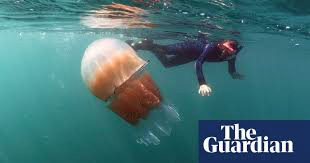
Let’s walk through Todd’s summer propaganda adventure. We’ll break down what the Illuminist
shill quoted in the mainstream news article said, and examine in detail the hedges it contains.
He said “They're not ‘too’ rare ‘but’ ‘usually’ it's a ‘sign of’ a ‘good’ summer.”
“But” is a hedge. Now, here’s the sentence with the hedge removed: “They’re rare. Usually its a sign of a good summer.”
“Too” is a hedge. Now, here’s the sentence with the hedge removed: “They’re rare. Usually it’s a sign of a good summer.”
“Usually” is a hedge. Now, here’s the sentence with the hedge removed: “They’re rare. It’s a sign of a good summer.”
“Sign of” is a hedge. Now, here’s the sentence with the hedge removed: “They’re rare. It’s a proof of a good summer.”
“Good” is a hedge. Now, here’s the sentence with the hedge removed: “They’re rare. It’s a proof of a great summer.”
Neither the author or Todd provide explanation of the mechanism by which exponentially more barrel jellyfish are baked into existence by a brief increase in the air temperatures over the waters they inhabit.
2002 is of interest, in that’s right around the time the literal forest of what we euphemistically refer to as “communications infrastructure” was thrown up seemingly overnight in all the nations.
I think it may be that the world was already energetically transforming for the better at that moment (as evidenced by the booming jellyfish population), and that Death energy-based “cell phone” technology was developed and deployed in a last-ditch effort to try to stop it. Right at the same time the aerosol operations got underway that still bizarrely continue to this day, albeit not on the levels previously undertaken.
In the future, grade school children will marvel that many people at this time would refer to me as “someone who believes in Chemtrails”.
I believe it was in 1997 that my best friend and I were standing on his back porch in our hometown of Emmaus, Pennsylvania. A huge, gorgeous thunderhead began forming behind the house as the sun was setting, and our mutual conclusion was “the world is transforming!” Somewhere in a scrapbook, I have a picture of it. That needs to be framed.
Aerosol operations got underway the next year, as did cell phone network construction.
In December 2015, the U.K.’s Daily Mail said “2015 ‘saw’ 'unprecedented' number of jellyfish in British waters”.
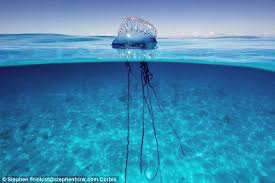
Where “saw” takes it back a step from actually experiencing it, and puts it firmly in the past tense, as if it were something that weren’t happening anymore.
The article continues: “The UK saw 'unprecedented' jellyfish ‘invasions’ in 2015, due to ‘warmer’ seas and ‘overfishing’, according to the ‘National Trust’.”
Where the Daily Mail psychotically describes a jellyfish population booming and burgeoning to unprecedented health as a jellyfish “invasion”. You can see the spit flying off their lips as they say it.
“Warm-er seas” and “overfishing” are a general plausible-deniability excuses, put forward because propagandists know that the subconscious of many or most readers will grasp virtually any straw, no matter how thin, to remain off the hook of personal responsibility.
As students of the subject, we know that the North Atlantic was colder than it had been in fifty years at the time this article was written. And so we have caught the Daily Mail telling a Big Lie with the firmness of purpose that goes with complete honesty. And, since we also know that the world fish trade hit an all-time high in 2017, we’ve caught them in a second. This is what was known in the old days as “fact checking”.
The folks in charge are not your friends, and are lying to you about basically everything, including the jellyfish.
In September 2016, BBC Earth said “ ‘Are ‘swarms’ of jellyfish ‘taking over the ocean’?
Where BBC Earth psychotically describes a jellyfish population booming and burgeoning to unprecedented health as “swarms” of jellyfish “taking over the ocean”. You can see the spit flying off their lips as they say it.
The words “mystery”, “baffled” and “puzzled” are memes, used, among numerous similar variants, whenever anyone in the wholly-controlled-and-coopted Political, Academic, Scientific and Media establishments wants to lie about, well, basically anything. One of those variants is “unusual”.
That’s why a Nambucca Guardian article from Australia from October 2016 says “Sightings of ‘unusual’ jellyfish in the NSW Great Lakes”.
Under the false guise of familiarity, the headline omits the word “Australia” to make the subject drastically less searchable. The word “unusual”, while cryptic, is also general.
“What's believed to be the first photograph of a live Desmonema scoresbyanna jellyfish in Australian waters was taken off Tuncurry's breakwall by Forster's Vicki Stewart.
The words “mystery”, “baffled” and “puzzled” are memes, used, among numerous similar variants, whenever anyone in the wholly-controlled-and-coopted Political, Academic, Scientific and Media establishments wants to lie about, well, basically anything. Two of those variants are “unexpected”, “unknowing”, and “excited”.
That’s why the article continues “It was an ‘unexpectedly’ rare sighting, ‘unknowingly’ captured by Forster’s Vicki Stewart near Tuncurry’s breakwall earlier this month, which got marine experts ‘excited’.
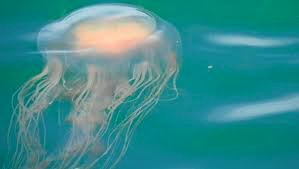
In fact, the scientifically ‘relevant’ finding of a rare Desmonema jellyfish in Australian waters – Forster’s waters, no less – gives proof to the old adage ‘if in doubt, ask’.
The ruse here is that you can just go out and randomly snap a picture, and you’ll catch one. “All you have to do is look”. They’re employing this tactic in the face of a creature which has never been seen in these waters previously. It’s a bold, blatant, mind-fucking tactic. The scientifically epochal finding is said to be merely “relevant”.
The article continues: “Now thanks to Vicki’s photograph of the lone jelly fish taken on October 7, Vicki has ‘unknowingly’ provided marine experts with their first ‘live’ image of a Desmonema in Australian waters - a rare sighting ‘apparently’.
Wait, what? It’s never been seen in these waters in history. And the ruse is played that it lives in these waters, only it ‘hasn’t been photographed’. “Their first “live” image implies falsely that there’s plenty of dead one’s that have been found and photographed, but that didn’t happen in actuality, or it would have been mentioned.
The article is discussing the fact that it’s the only sighting ever in these waters, and the dismissive “a rare sighting ‘apparently’ “ is disdainfully tacked on the end.In October 2017, the U.K.’s Mirror said “ ‘Invasion’ of ‘killer’ 'jellyfish' on Britain's shores is biggest EVER recorded”.
Where the Mirror psychotically describes a jellyfish population booming and burgeoning to unprecedented health as a jellyfish “invasion”. You can see the spit flying off their lips as they say it.
The U.K.’s Independent and Daily Mail are both in lock-step on the “invasion” meme because they’re part of the same larger propaganda organization. For any lingering Coincidence Theorists in the readership, a third example of the international conspiracy I’m exposing here is found in Outdoor Life’s May 2012 story headlined “ ‘Signs of the Apocalypse’: 15 ‘Weird’ Animal ‘Invasions’ “.
It’s the Middle Ages, and you are living in it, and you are loving it. Except for the invasions, which are, by the way, “weird”.
The Mirror continues: “It ‘amounts to’ the greatest number of Portuguese man-of-war recorded in the UK since records began in 2003.”
Where “amounts to” is a bizarre little hedge, to get your subconscious off onto “will never amount to anything”. The non-deviant way to write the headline is “It ‘is’ the greatest number”.
A “Global News” article from April 2020 is headlined “Jellyfish ‘spotted’ in Venice canal as coronavirus clear-up continues”.

The words “mystery”, “baffled” and “puzzled” are memes, used, among numerous similar variants, whenever anyone in the wholly-controlled-and-coopted Political, Academic, Scientific and Media establishments wants to lie about, well, basically anything. One of those variants is “startling”.
That’s why the article goes on to say “A biologist in Italy recorded startling footage earlier this month of a near-transparent jellyfish swimming in the crystal-clear waters of the Venice canals as the city’s waterways continued to clear up amid the ongoing coronavirus lockdown.”
The “virus did it” meme continues: “Venice officials say the city’s canals have cleared up over the last month because boat traffic is no longer ‘stirring up sediment’ in the water. In other words, nature hasn’t ‘exactly’ “healed” from the pollution caused by humans, but it’s enjoying a ‘little’ break right ‘now’.
The “pollution” that the Covid is alleged to have alleviated is general. Not “exactly” healed is the Big Lie, told by a Trusted Authority Figure with the firmness of purpose that goes with complete honesty. An environment that is booming and burgeoning to an historically unprecedented level is flatly maintained to be “not ‘exactly’ healed”. The author hedges again that it’s only a “little” break, and that the little break is only taking place right now, and will stop in the future.